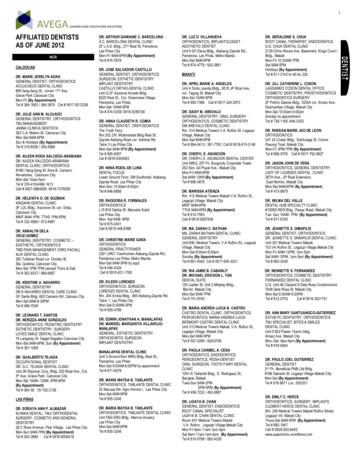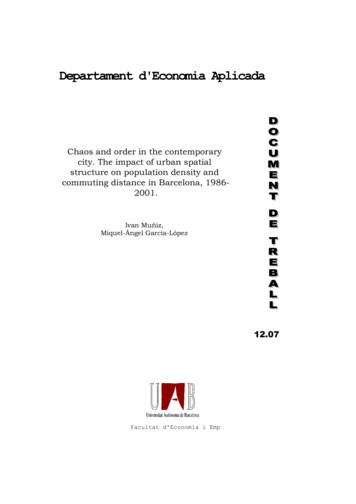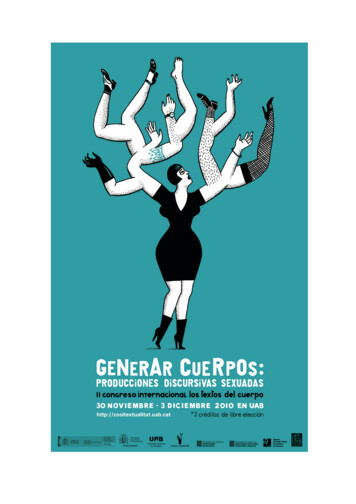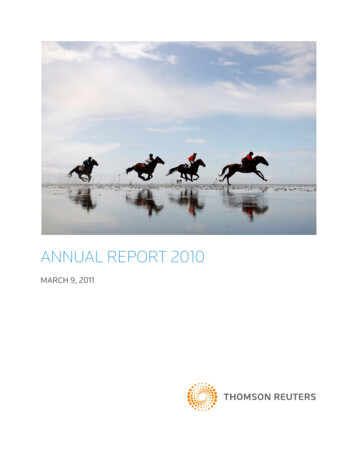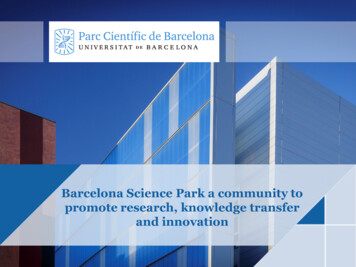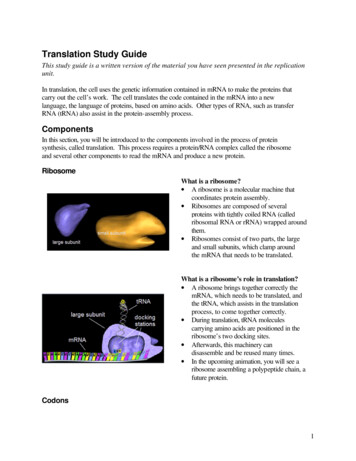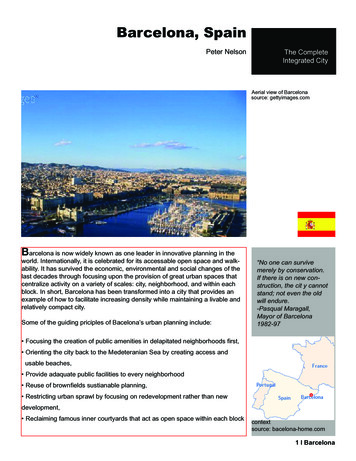
Transcription
Barcelona, SpainPeter NelsonThe CompleteIntegrated CityAerial view of Barcelonasource: gettyimages.comPhotoBarcelona is now widely known as one leader in innovative planning in theworld. Internationally, it is celebrated for its accessable open space and walkability. It has survived the economic, environmental and social changes of thelast decades through focusing upon the provision of great urban spaces thatcentralize activity on a variety of scales: city, neighborhood, and within eachblock. In short, Barcelona has been transformed into a city that provides anexample of how to facilitate increasing density while maintaining a livable andrelatively compact city.Some of the guiding priciples of Bacelona’s urban planning include:“No one can survivemerely by conservation.If there is on new construction, the cit y cannotstand; not even the oldwill endure.-Pasqual Maragall,Mayor of Barcelona1982-97 Focusing the creation of public amenities in delapitated neighborhoods first, Orienting the city back to the Medeteranian Sea by creating access andusable beaches, Provide adaquate public facilities to every neighborhood Reuse of brownfields sustianable planning, Restricting urban sprawl by focusing on redevelopment rather than newdevelopment, Reclaiming famous inner courtyards that act as open space within each blockcontextsource: bacelona-home.com1 I Barcelona
City StatisticsCity Population:1,582,000 (2003)City Area:101 km2Density Level:14.9 people / km2Governing bodies:City of BarcelonaBarcelona City CouncilDensity growthContextThe foundation for Barcelona’s transformation has been the city’s Eixample district, aseries of 520 street blocks planned on a grid with major boulevards cutting through thepattern at 45 degree angles. The visionary urban planner Ildefons Cerdá worked on thedesign for twenty years and has been an example to planners ever since the1860 planwas implemented. Its high quality architecture, attention to community green space onlarge and small scales, and ease of access have stood the test of time and still providea city that people from around the world love to visit.Essential Planning Timeline1860- Walls surrounding Barcelona demolished to make way forIldefons Cerdá’s Plan for Urban Renewal1975- End of Fraquismo and beginning of democracy1976 - General Metropolitan Plan Implemented1979 - First democratic municipal elections were celebrated1980’s - City is transformed in preparation for the 1992 Olympics1980 - Architect Oriol Bohigas arrived in the city council1983 - The inauguration of public spaces started1982-92 - More than 490 acres of park had been gained (while 40years of Franco produced only 172 acres)Diagram of .com2 I Barcelonasource:geographyfieldwork.com,
“.getting the authorities to give us a set of traffic lights meantforty days of barricades and stopping cars coming into the districtwhere four or five fatal accidents had taken place” -Avelina PerezUrban RenewalCity nameThe Completetag lineIntegratedCity(arial 18pt)The major catalyst of the modern transformation of Barcelona in the eighties to thepresent was the 1992 Olympics. With the end of a long dictatorship known as Franquismo, the city took advantage of its new found democracy as the Urban Social Movement began. Faced with serious problems of urban decay in both inner and peripheraldistricts, planners used the Games to gain enough funding to complete an amount ofreconstruction that would take any city decades to accomplish.Olympic facilities were built on neglected urban areas, with the Olympic Village, developed on brownfields close to the coast. The rail lines that cut and divided the city fromthe sea were opened and for the first time in its history, Barcelona has been able to turnand face the sea with pride. Six artificial beaches were created to handle the capacityof tourists that would be in the city for the upcoming Games.photo/diagram/sketchThis change was championed by one planner in particular, Oriol Bohigas, who used theGames as a springboard to built more than two hundred parks, plazas, schools, andother public facilities in Barcelona. Most of these amenities were inserted into derelictareas where crime was high. In one area in particular, El Rival, buildings were retrofitted to house a modern museum, police station, and other amenities.Progression over sca.eshttp://www.bcn.es/22@bcn/Olympic games 1992source: preview.britannica.co.kr3 I Barcelona
“Barcelona is absolutely a world class city. From its architecture to its boulevards to its parks, it is a vast, diverse, center of culture and entertainment. Itliterally pulsates with energy.” -Fred Kent (Project for Public Spaces)Lessons LearnedOpen city to waterfrontDuring the eighties, the city of Barcelona realized the value of there position on Mediterranean. Until then, they had been dumping contaminates in to the sea and makingit unusable for the people. Also, there were rail lines that followed the shoreline andmade a barrier from the city. They determined to redirect the rail lines and to create sixartificial beaches in preparation for the Olympics.Get your priorities straightDuring the incredible revitalization in the eighties, the city prioritized the creation andreconstruction of public amenities. The city worked fast and were able to gain the approval of the community through smart planning.Sustainable developmentThe topography in Barcelona has kept the city fairly compact. This has been beneficialfor sustainability and has forced planners to look for creative ways to reuse much ofthe infrastructure. As heavy industry and shipping become less prevalent, the city hastaken advantage of industrial sites for development. Right now much of the sea front inbeing claimed for a new high technology center with an emphasis on open space andparks.Las Ramblassource: pps.orgLas Ramblas: One of Barcelona’s great BoulevardsIn a city know for great public spaces, Las Ramblas could be the greatest of themall. With a variety of cafe’s, shops, and markets, tourists are presented with endlessentertainment. There are a huge number of pedestrians and people-watchers, andenough street performers and artists to attract even the local Catalans. About 1.5kilometers long, Las Ramblas are really a series of three pedestrian-oriented boulevards that link the city to the waterfront. Its central pedestrian promenade is unique inthat it is wide enough to be lined on either side by seating for restaurants, or a flowerstand while leaving abundant space to fit hundreds of people. Towering street treesand adequate seating are also pluses.The street is lined with five-to-seven-story buildings, and the central walkway is, onaverage, 60 feet wide. The sidewalks are usually less than 10 feet wide, encouraging walking in the center. Pedestrians have precedence while cars are restricted tonarrow lanes on either side of the promenade and must accommodate pedestriansat every intersection.Artists, musicians, and magicians all flock to Las Ramblas to try and awe and amazethose passing by. People are constantly strolling up and down the promenade at anytime of day to catch something new and interesting. This is truly a great public spaceand is full of life and community. The lesson here is to rethink how we prioritize carsand start accommodating the pedestrian. This is what creates community.Las Ramblas4 I Barcelonasource: pps.org
CitynameThe CompleteIntegratedCitytag line(arial 18pt)ResourcesCity of Barcelona Urban Planning Sitehttp://www.bcn.es/urbanisme/Project for Public Spaceswww.pps.orgCurrent Urban Planning in n/Barcelona Forum 2004http://www.barcelona2004.org/eng/photo, group of photos ordiagramsUrban Planning field study on tmMaragall, Pasqual and Benach, Nuria and Bohigas, Oriol. Transforming Barcelona.New York: Routledge. 2004.Frampton, Kenneth and Maragall, Pasqual and Bohigas, Oriol. Barcelona: Spaces andSculptures. Barcelona. 1987.Gehl, Jan and Gemz oe, Lars. New City Spaces. Copenhagen. 2001.photo, group of photos ordiagramssource: azuradec.typepad.com/photos/barcelonaGuadisource: crystalcanyons.net5 I Barcelona
Urban Renewal The major catalyst of the modern transformation of Barcelona in the eighties to the present was the 1992 Olympics. With the end of a long dictatorship known as Fran-quismo, the city took advantage of its new found democracy as the Urban Social Move-ment began. Faced with serious problems of urban decay in both inner and peripheral



